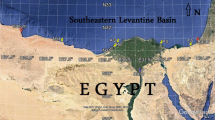Abstract
This paper describes the characteristics of sea breezes over the coastal region of Nigeria. While considerable attention has been paid to monsoon circulation over this coastal region, there is virtually no information in literature on sea breezes over the region. This study analyzed 5 years (1979–1983) data of hourly temperature and wind speed and direction from four coastal stations in Nigerian—Lagos, Warri, Port-Harcourt, and Calabar—in order to examine the characteristics of the sea breeze in the region. The results show that sea breeze usually started between 1000 and 1200 UTC, attained maximum strength of about 2–5 m s−1 in the afternoon around 1500–1600 UTC and subsided between 2000 and 2200 UTC. Consistent with maxima temperature contrast between land and sea, the maximum frequency of sea breeze occurs in February–May and September–November, with duration of about 11–13 h. The diurnal variation of wind vectors with time, portrayed by means of hodograph, shows that sea breeze rotates clockwise and anticlockwise over the region. We found that only the stations adjacent to bay demonstrate clockwise rotation during the day.









Similar content being viewed by others
References
Abbs DJ, Physick WL (1992) Sea-breeze observations and modelling: a review. Aust Meteor Mag 41:7–19
Adedokun JA (1978) West African precipitation and dominant atmospheric mechanism. Arch Met Geoph Biokl Ser A 27:289–310
Adefolalu DO (1984) Weather hazards in Calabar—Nigerian. GeoJournal 9(4):359–368
Adekoya LO, Adewale AA (1992) The wind energy potential of Nigeria. Renewable Energy 2:35–39
Adeyewa ZD, Holmgren B, Adedokun JA (1995) Spectral solar irradiance under Harmattan conditions. Renewable Energy 6:989–996
Banfield CE (1991) The frequency and surface characteristics of sea breeze at St. Johns, Newfoundland. Climatol Bull 25(1):3–20
Barkan J, Feliks Y (1993) Observations of the diurnal oscillation of the inversion over the Israeli coast. Boundary-Layer Meteor 62:393–409
Borne K, Chen D, Nunez M (1998) A method for finding sea breeze days under stable synoptic conditions and its application to the Swedish west coast. Int J Climatol 18:901–914
Bouchlaghem K, Mansour FB, Elouragini S (2007) Impact of a sea breeze event on air pollution at the eastern Tunisian coast. Atmos Res 86:162–172
Burpee RW, Lahiff LN (1984) Area-average rainfall variations on sea-breeze days in south Florida. Mon Wea Rev 112:520–534
Davis WM, Schultz LG, Ward RD (1889) An investigation of the sea-breeze. New Engl Meteor Soc Obser 21:214–264
Furberg M, Steyn DG, Baldi M (2002) The climatology of sea breezes on Sardinia. Int J Climatol 22:917–932
Gustavsson T, Lindqvis S, Borne K, Bogren J (1995) A study of sea and land breezes in an archipelago on the West coast of Sweden. Int J Climatol 15:785–800
Halley E (1686) An historical account of the trade winds, and monsoons, observable in the seas between and near the tropicks, with an attempt to assign physical cause of said winds. Trans Roy Soc London 16:153–168
Hamilton RA, Archbold JM (1945) Meteorology of Nigeria and adjacent territory. Quart J Roy Meteor Soc 71:231–265
Hayward DF, Oguntoyinbo JS (1987) Climatology of West Africa. Rowman and Littlefield, Lanham
Haurwitz B (1947) Comments on the sea-breeze circulation. J Meteorol 4:1–8
Kusuda M, Alpert P (1983) Anti-clockwise rotation of the wind hodograph. Part I: theoretical study. J Atmos Sci 40:487–499
Jegede OO, Fasheun TA, Adeyefa ZD, Balogun AA (1997) The effect of atmospheric stability on the surface-layer characteristics in a low-wind area of tropical West Africa. Boundary Layer Meteorology 85:309–323
Miller STK, Keim BD, Talbot RW, Mao H (2003) Sea breeze: structure, forecasting, and impacts. Rev Geophys 41:1–31
Mounier F, Kiladis GN, Janicot S (2007) Analysis of the dominant mode of convectively Kelvin waves in the West African monsoon. J Climate 20:1487–1503
Omotosho JB (1988) Spatial variation of rainfall in Nigeria during the little dry season. Atmospheric Research 22:137–147
Orlic M, Penzar B, Penzar I (1988) Adriatic sea and land breezes: clockwise versus anticlockwise rotation. J Appl Met 27:675–679
Physick WL, Abbs DJ (1992) Flow and plume dispersion in a coastal valley. J Appl Meteorol 31:64–73
Prtenjak MT (2003) Main characteristics of sea/land breezes along the eastern coast of the Northern Adriatic. Geofizika 20:75–92
Prtenjak MT, Grisogono B (2007) Sea/land breeze climatological characteristics along the northern Croatian Adriatic coast. Theor Appl Climatol 90:201–215. doi:10.1007/s00704-006-0286-9
Rhome JR, Niyogi DDS, Raman S (2003) Assessing seasonal transport and deposition of agricultural emissions in eastern North Carolina, USA. Pure Appl Geophys 160:117–141
Simpson JE (1994) Sea breeze and local winds. Cambridge University Press, Cambridge
Simpson M, Warrior H, Raman S, Aswathanarayana PA, Mohanty UC, Suresh R (2007) Sea-breeze-initiated rainfall over the east coast of India during the Indian southwest monsoon. Nat Hazard 42:401–413
Sultan B, Janicot S (2003) The West African monsoon dynamics. Part II: The “Preonset” and “Onset” of the summer monsoon. J Climate 16:3407–3427
Xian Z, Pielke RA (1991) The effects of width of landmasses on the development of sea breeze. J Appl Met 30:1280–1304
Acknowledgments
The authors appreciate the Nigerian Meteorological Agency for providing the surface observation data used for the present work. This work was finalized during the period the first author was doing his Ph.D. at Iowa State University, Ames, Iowa USA. The program was supported by U.S. Department of Energy grants DEFG0201ER63250 and DEFG0208ER64534 under the supervision of Dr. Gutowski William Jr. His effort at proof reading this work is also gratefully acknowledge. We give all honor to God for successful completion of this work.
Author information
Authors and Affiliations
Corresponding author
Rights and permissions
About this article
Cite this article
Abatan, A.A., Abiodun, B.J. & Omotosho, B.J. On the characteristics of sea breezes over Nigerian coastal region. Theor Appl Climatol 116, 93–102 (2014). https://doi.org/10.1007/s00704-013-0931-z
Received:
Accepted:
Published:
Issue Date:
DOI: https://doi.org/10.1007/s00704-013-0931-z




